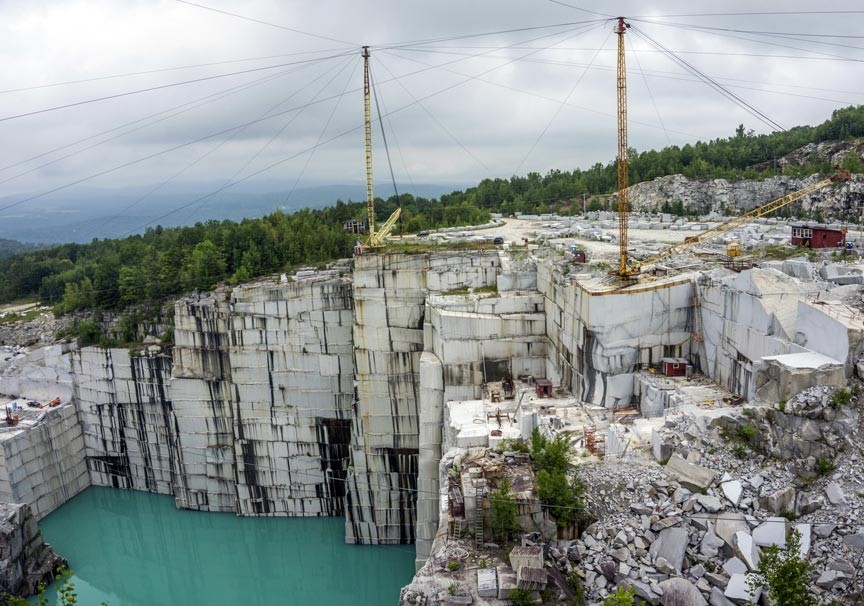Introducing the Mysteries of Granite Quarrying: Where Strength and Sophistication Meet
The globe of granite quarrying is a realm where the raw stamina of nature merges with human artistry to produce structures that stand the examination of time with an air of elegance. From the depths of quarries to the careful sprucing up in workshops, the process of transforming granite right into building wonders is a complex dance of custom and technology. As we peer into the depths of this old craft, we start to reveal the hidden complexities that shape the very significance of our built environment.
The Beginnings of Granite Quarrying
In the record of architectural history, the origins of granite quarrying are shrouded in a tapestry of ancient craftsmanship and geological marvels. Dating back to ancient Egypt and Mesopotamia, the extraction of granite from quarries marked the beginning of a journey that would eventually result in the development of a few of the world's most famous frameworks.
Granite quarrying's origins can be traced to the experienced artisans who acknowledged the stone's sturdiness and visual allure. Via a mix of primitive devices and large decision, these early quarry workers unearthed granite blocks that would certainly come to be the structure blocks of civilizations.
As civilizations evolved, so did the techniques of quarrying granite. The Romans, renowned for their design expertise, established sophisticated techniques for extracting granite to construct monoliths, holy places, and roadways that stood the test of time.
The legacy of these ancient quarrying techniques remains to shape modern architecture, with granite continuing to be an icon of stamina and beauty in building tasks around the world. (granite quarries in south africa)
Devices of the Quarrying Trade
The advancement of granite quarrying strategies from ancient worlds to modern times highlights the essential duty played by the devices of the quarrying trade in forming the industry's techniques. In ancient times, quarrying tools were simple, frequently being composed of blades, hammers, and wedges made from materials like bronze or iron. These tools called for considerable manpower and time to remove granite blocks from quarries.

Additionally, the introduction of pneumatic tools and high-powered machinery has significantly decreased the physical labor required in quarrying procedures, enhancing worker safety and security and productivity. As the quarrying sector proceeds to introduce, the devices of the profession stay at the leading edge of driving development and shaping the future of granite extraction.
Removing Blocks of Granite
Using accuracy machinery and advanced strategies, the removal of granite obstructs from quarries has ended up being an advanced process in the modern quarrying sector. The first action entails recognizing the place and size of the granite deposit to determine one of the most effective extraction method. As soon as an appropriate site is selected, the removal process begins with the exploration of openings for the placement of nitroglycerins. Regulated blasting techniques are after that utilized to disintegrate the granite right into workable areas.

Sprucing Up and Ending Up Methods
To achieve a flawless surface area on granite blocks, competent artisans use a collection of precise polishing and ending up strategies. After the first extraction and forming processes, the granite obstructs go through an extensive polishing stage to improve their all-natural beauty and resilience. One usual technique used in brightening granite is ruby abrasion, where commercial rubies are made use of to grind and brighten the rock to a smooth coating. This procedure not just develops a shiny surface area however also guarantees uniformity in shade and appearance throughout the granite block.
In enhancement to polishing, completing strategies are related to more fine-tune the granite's appearance. These methods may include flaming, developing, or cleaning, each offering one-of-a-kind structures and finishes to fit different aesthetic choices. Flaming, for instance, involves exposing the granite surface area to heats to produce a harsh, distinctive finish, perfect for outside applications where slip-resistance is vital. Honing, on the other hand, provides a matte coating that is smooth to the touch, excellent for indoor kitchen counters and floor covering. By carefully selecting and using these brightening and finishing techniques, artisans can transform raw granite obstructs into elegant pieces that display both toughness and elegance.

Environmental Impact and Sustainability
With the expanding focus on environmental consciousness in the market, granite quarrying practices are significantly looked at for their influence on natural deposits and long-term sustainability. Quarrying for granite can have considerable environmental implications. The removal process typically entails using hefty equipment, nitroglycerins, and large quantities of water, resulting in habitat devastation, dirt erosion, and water pollution. Additionally, the transport of granite from quarries to processing facilities creates carbon discharges, additionally adding to environmental degradation. granite quarries in south africa.
To reduce these effects and make certain sustainability in granite quarrying, link industry stakeholders are adopting various actions. Implementing innovative modern technologies to minimize power intake and water use, redeeming quarried land for eco-friendly reconstruction, and advertising responsible sourcing techniques are some techniques being employed. In addition, certifications such as the Woodland Stewardship Council (FSC) and the Management in Energy and Environmental Style (LEED) help consumers recognize ecologically pleasant granite products.
Final Thought
Finally, granite quarrying my link is a procedure that needs specialized tools and methods to extract blocks of granite and polish them to a high degree of finish. While the environmental impact of quarrying can be significant, initiatives are being made to improve sustainability methods in the market. On the whole, granite quarrying is a delicate balance in between taking advantage of the stamina and style of this all-natural stone while decreasing its effect on the atmosphere.